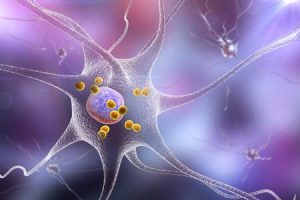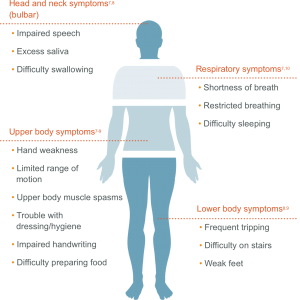Overview of ALS
Amyotrophic lateral sclerosis is a neurodegenerative disease that damages motor neurons of the central nervous system. This results in motor control problems and cognitive deficits that leave the person unable to live a normal life. Unfortunately, the only current treatments for this disease either slow symptom progression or reduce pain for end of life care. A more in depth understanding of the disease is necessary for developing a more permanent treatment option.

What we known about the disease
Two physiological processes play a role in the onset of ALS: oxidative stress and abnormal RNA metabolism. Oxidative stress occurs when too many free radicals exist within cells and cause too many oxidative reactions to occur. This can produce toxicity in the cell and eventual cell death. RNA dysmetabolism involves an issue with how RNA molecules are processed within the cell. Normally, RNA is cut up and spliced back together in a very specific way before it is utilized in the cell. With ALS, there is evidence that something does not work properly during this metabolism causing them to stick together and also creating cell toxicity. To complicate the story even further, there two processes have been shown to interact with each other resulting in a vicious cycle.
With a basic understanding of the pathology of the disease, it now makes sense why ALS progresses so quickly. Unlike other neurodegenerative diseases, which can take decades to fully develop, ALS can progress to a fatal stage within a couple years after diagnosis. People often begin to have problems moving their hands or arms and will quickly progress to have walking problems and end up in a wheel chair. Due to its damage to motor neurons, many people with ALS die of asphyxiation because their motor neurons controlling the diaphragm fail to function.

Why motor neurons?
An interesting characteristic of ALS is that, for the most part, it only affects motor neurons. While it is understood that oxidative stress and RNA problems contribute to the progression of the disease, it does not explain why specifically motor neurons are the only cells that become damaged. One theory is that since motor neurons require so much energy, they are the first cells to die when an imbalance occurs. Motor neurons are the longest cells in the body, as many of them in the spinal cord can reach up to a meter long. You can imagine if there is anything that messes with energy metabolism in the cell, it will quickly become ineffective and die.
More recent research has looked more closely into answering why motor neurons are particularly targeted in ALS. One study found that the problems associated with RNA metabolism could play an even larger role than previously thought. TAR DNA binding protein 43 (TPD43) is a protein that assists in the processing of RNA. It tells other enzymes where to cut and how to piece RNA back together. This protein has been shown to be useful in processing an RNA transcript coding for a survival motor neuron protein (SMN). Without SMN, the motor neuron is more vulnerable to death. Perhaps people with ALS have a deficiency in the TPD43 protein which causes less SMN to be produced contributing to motor neuron death.
Final thoughts
Although some is known about the pathophysiology of ALS, we have a long way to go before developing a cure. Even though the prevalence of ALS is not as high as similar neurodegenerative diseases, its rapid rate of progression sets it apart. Families dealing with ALS suffer a great deal by having to watch a loved one deteriorate and lose all ability to live their normal life. ALS can occur so quickly and unexpectedly that it can tear families apart. I hope in the future we will see progress in understanding this tragic disease and become better at treating it from the source.
Sources:
http://www.alsa.org/research/focus-areas/disease-mechanisms/
https://ghr.nlm.nih.gov/gene/SMN1
https://www.ncbi.nlm.nih.gov/pmc/articles/PMC2661999/
https://www.123rf.com/clipart-vector/neurodegenerative_disease.html?sti=mluwnyxb2pzuijnu4p|
alspathways.com